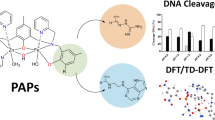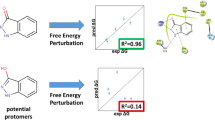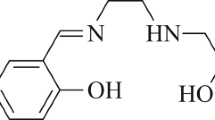Abstract
The development of protease’s inhibitors is an active field of research in the pharmaceutical industry. As concerns the design of new inhibitors, the theoretical study of the binding patterns and energies of known metal binding groups (MBGs) toward Zn 2+ using quantum-chemical calculations may offer a better understanding of their interaction models and may be useful for the improvement and design of novel ZBGs. Here the properties of gem-Ge(OH)2-based compounds as ZBG were assessed theoretically using DFT calculations. [Zn(Imdz)2 R − OH 2]2+ complexes (Imdz =imidazole rings; R = imidazole ring, acetic acid molecule or acetate anion) were used to partially reproduce the coordination sphere in metalloproteases (ACE, amgiotensin converting enzyme, and TLN, thermolysine) being inhibited by related compounds (i.e., silanediols). The MBG- Zn 2+ interaction was analyzed through the energy of the reaction: [Zn(Imdz)2 R − OH 2]2+ + L → [Zn(Imdz)2 R − L]2+ + H 2 O using DFT (M06L/cc-pVDZ) in gas-phase and in solution (IEF-PCM). Although the functional used (M06L) has proven its efficiency to study systems containing transition metal governed by non-covalent interactions, dispersion effects were implemented by the correction of the computed energies using the DFT-D3 program. Accounting for dispersion effects produced a systematic increase of c.a. 13 kJ mol−1 on the energies, whereas the effect of solvent goes in the opposite direction (i.e., BE under the IEF-PCM model are on average 125 kJ mol−1 lower). The Ge(OH) 2 - Zn 2+ interaction seems to be similar (or even stronger) than the Si(OH)2 -Zn 2+. Their better performance as ZBG is explained by the combined NBO-AIM analysis. The results of this work may encourage the preparation, isolation, and experimental assay of the chelating properties of these compounds, which may propose a new family of protease’s inhibitors.





Similar content being viewed by others
References
Kluska M (2008) Some aspects of the analysis of biologically active organogermanium substances. Crit Rev Anal Chem 38:84–92, and references therein
Menchikov LG, Ignatenko MA (2013) Biological activity of organogermanium compounds (a review). Pharm Chem J 46:635–638, and references therein
Ishiwara F (1928) The influence of different types of metals on mouse carcinoma. Ber Ges Physiol Exp Pharm 49:615–618
Lukevits E, Ya GTK, Ignatovich LM, Mironov VF (1990) Biological Activity of Germanium Compounds. Zinatne, Riga
Lukevics E, Ignatovich L (1992) Comparative study of the biological activity of organosilicon and organogermanium compounds. Appl Organomet Chem 6:113–126
Bo Y, Singh S, Duong HQ, Cao C, McN SS (2011) Efficient, enantioselective assembly of silanediol protease inhibitors. Org Lett 13:1787–1789, and references therein
Wa MM, Nittoli T, Guo L, McN SS (2002) Silicon-based metalloprotease inhibitors: synthesis and evaluation of silanol and silanediol peptide analogues as inhibitors of angiotensin-converting enzyme. J Am Chem Soc 124:7363–7375
Kim J, Glekas A, McN SS (2002) Silanediol-based inhibitor of thermolysin. Bioorg Med Chem Lett 12:3625–3627
Sieburth S, McN NT, Guo Mutahi L (1998) Silanediols: a new class of potent protease inhibitors. Angew Chem Int Ed 37:812–814
Sieburth S, McN CC-A (2006) Silanediol protease inhibitors: from conception to validation. Eur J Org Chem 2006:311–322
Rodríguez Ortega PG, Montejo M, López González JJ (2014) Interaction models of the Si(OH)2 functionality with Zn2+ cation in simplified biological environments. A DFT study. Struct Chem 25:127–138
Frison G, Ohanessian G (2008) A comparative study of semiempirical, ab initio, and DFT methods in evaluating metal-ligand bond strength, proton affinity, and interactions between first and second shell ligands in Zn-biomimetic complexes. J Comput Chem 29:416–433
Cheng F, Zhang R, Luo X, Shen J, Li X, Gu J, Zhu W, Shen J, Sagi I, Ji R, Chen K, Jiang H (2002) Quantum chemistry study on the interaction of the exogenous ligands and the catalytic zinc ion in matrix metalloproteinase. J Phys Chem B 106:4552–4559
Smieško M, Remko M (2003) Coordination and thermodynamics of stable Zn(II) complexes in the gas phase. J Biomol Struct Dyn 20:759–770
Zhao Y, Truhlar DG (2008) The M06 suite of density functionals for main group thermochemistry, thermochemical kinetics, noncovalent interactions, excited states, and transition elements: two new functionals and systematic testing of four M06-class functionals and 12 other functionals. Theor Chem Accounts 120:215–241
Amin EA, Truhlar DG (2008) Zn coordination chemistry: development of benchmark suites for geometries, dipole moments, and bond dissociation energies and their use to test and validate density functionals and molecular orbital theory. J Chem Theory Comput 4:77–85
Sorkin A, Iron MA, Truhlar DG (2008) Density functional theory in transition-metal chemistry: relative energies of low-lying states of iron compounds and the effect of spatial symmetry breaking. J Chem Theory Comput 4:307–315
Cramer J, Truhlar DG (2009) Density functional theory for transition metals and transition metal chemistry. Phys Chem Chem Phys 11:10757–10816
Zeng Y, Wang S, Feng H, Xie Y, King RB (2011) Highly unsaturated binuclear butadiene iron carbonyls: quintet spin states, perpendicular structures, agostic hydrogen atoms, and iron-iron multiple bonds. Int J Mol Sci 12:2216–2231
Zhao Y, Truhlar DG (2006) A new local density functional for main-group thermochemistry, transition metal bonding, thermochemical kinetics, and noncovalent interactions. J Chem Phys 125:194101–194118
Woon DE, Dunning TH Jr (1993) Gaussian basis sets for use in correlated molecular calculations. III. The atoms aluminum through argon. J Chem Phys 98:1358–1371
Frisch MJ, Trucks GW, Schlegel HB, et al. (2009) Gaussian 09, Revision B.01. Gaussian, Wallingford
Reed AE, Curtiss LA, Weinhold F (1988) Intermolecular interactions from a natural bond orbital, donor-acceptor viewpoint. Chem Rev 88:899–926
Glendening ED, Reed AE, Carpenter JE, Weinhold F (1988) NBO v 3.1, Madison
Bader RFW (1990) Atoms in molecules. A quantum theory. Oxford University Press, New York
Biegler-König FW, Schönbohm J (2002) Update of the AIM2000-program for atoms in molecules. J Comput Chem 23:1489–211494
Biegler-König F, Schönbohm J (2000) AIM2000. University of Applied Sciences, Bielefeld
Miertus S, Scrocco E, Tomasi J (1981) Electrostatic interaction of a solute with a continuum. A direct utilization of ab initio molecular potentials for the prevision of solvent effects. Chem Phys 55:17–129
Tomasi J, Mennucci B, Cammi R (2005) Quantum mechanical continuum solvation models. Chem Rev 105:2999–3093
Mennucci B, Cances E, Tomasi J (1997) Evaluation of solvent effects in isotropic and anisotropic dielectrics and in ionic solutions with a unified integral equation method: theoretical bases, computational implementation, and numerical applications. J Phys Chem B101:10506–10517
Cances E, Mennucci B, Tomasi J (1997) A new integral equation formalism for the polarizable continuum model: theoretical background and applications to Isotropic and anisotropic dielectrics. J Chem Phys 107:3032–3041
Cances E, Mennucci B (1998) New applications of integral equations methods for solvation continuum models: ionic solutions and liquid crystals. J Math Chem 23:309–326
Kristyán S, Pulay P (1994) Can (semi) local density functional theory account for the London dispersion forces? Chem Phys Lett 229:175–180
Grimme S, Anthony J, Ehrlich S, Krieg H (2010) A consistent and accurate ab initio parametrization of density functional dispersion correction (DFT-D) for the 94 elements H-Pu. J Chem Phys 132:154104–154119
McCall KA, Huang C-C, Fierke CA (2000) Function and mechanism of zinc metalloenzymes. J Nutr 130:1437S–1446S
Ignatyev IS, Montejo M, Rodríguez Ortega PG, López González JJ (2013) Quantum chemical study of silanediols as metal binding groups for metalloproteases inhibitors. J Mol Model 19:1819–1834
Chen C-A, Sieburth S, McN GA, Hewitt GW, Trainor GL, Erickson-Viitanen S, Garber SS, Cordova B, Jeffry S, Klabe RM (2001) Drug design with a new transition state analog of the hydrated carbonyl: silicon-based inhibitors of the HIV protease. Chem Biol 8:1161–1166
Gupta SP (2007) Quantitative structure-activity relationship studies on zinc-containing metalloproteinase inhibitors. Chem Rev 107:3042–3087
Wyvratt MJ, Patchett AA (1985) Recent developments in the design of angiotensin-converting enzyme inhibitors. Med Res Rev 5:483–531
Kimura E (2001) Model studies for molecular recognition of carbonic anhydrase and carboxypeptidase. Acc Chem Res 34:171–179
Wu Y-D, Gellman S (2008) Peptidomimetics. Acc Chem Res 41:1231–1232
Nielsen L, Skrydstrup T (2008) Sequential C-Si bond formations from diphenylsilane: application to silanediol peptide isostere precursors. J Am Chem Soc 130:13145–13151
Tacke R, Wannagat U (1979) Syntheses and properties of bioactive organo-silicon compounds. Top Curr Chem 84:1–75
Popelier P (2000) Atoms in molecules. An introduction. Pearson Education, Manchester
Acknowledgments
The authors thank Andalussian government for funding (FQM173). P.G.R.O. thanks Spanish Ministerio de Educación for a FPU Ph.D. studentship (AP2009-3949) supporting this work.
Author information
Authors and Affiliations
Corresponding author
Additional information
This paper belongs to Topical Collection QUITEL 2013
Electronic supplementary material
Below is the link to the electronic supplementary material.
ESM 1
(DOCX 20 kb)
Rights and permissions
About this article
Cite this article
Ortega, P.G.R., Montejo, M. & González, J.J.L. Study of the chelating properties of Ge(OH)2 functionality as metal binding group for Zn2+ cation in simplified protease-like environments: a DFT analysis. J Mol Model 20, 2430 (2014). https://doi.org/10.1007/s00894-014-2430-2
Received:
Accepted:
Published:
DOI: https://doi.org/10.1007/s00894-014-2430-2




